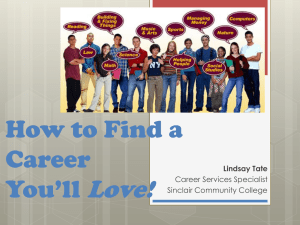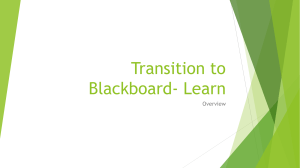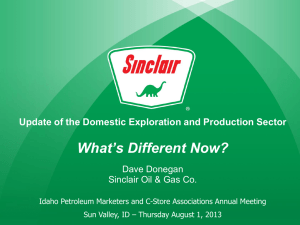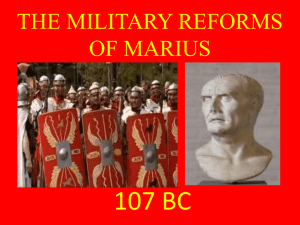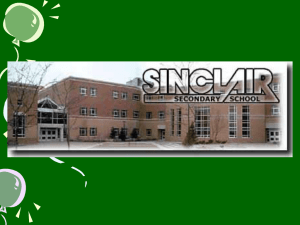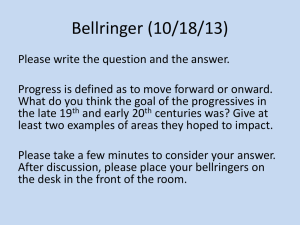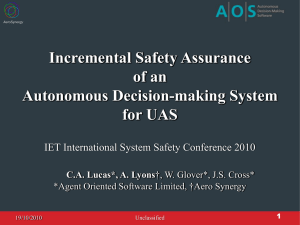Sinclair Student Success Initiatives, Dr. Steven Lee Johnson
advertisement
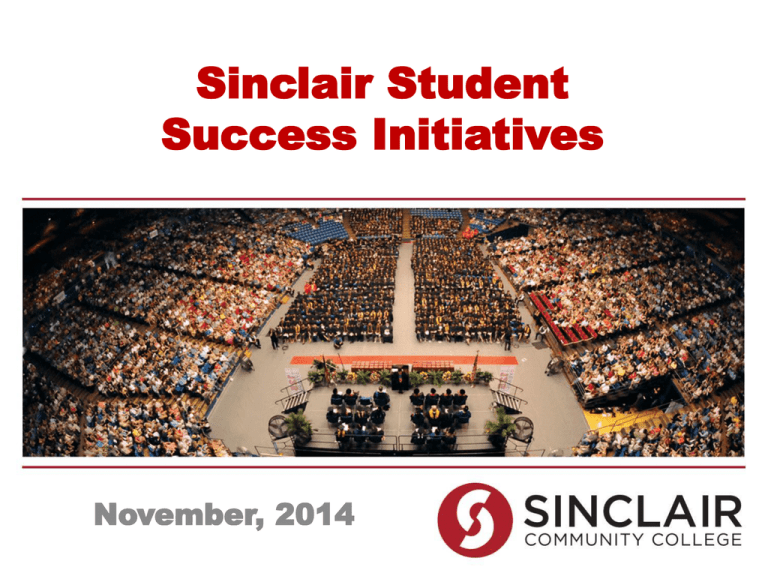
Sinclair Student Success Initiatives November, 2014 Sinclair College Board of Trustees Sinclair . . . • Founded in Dayton in 1887 • Fall enrollment of about 22,000 students (35,000 unique individuals study for college credit at Sinclair annually) • Operating budget of $125 million • Over 220 programs of study Student Success What Happens to Sinclair Students Over Time? A Longitudinal Cohort Analysis 19982002 1998 1999 2000 2001 2002 2003 2007 2003 2004 2005 2006 2007 20082012 2008 2009 2010 2011 2012 Vanguard CCTI Achieving the Dream New Library MAP Completion by Design Graduated and/or transferred and/or still enrolled and making progress (1998, 2003, and 2008 fall cohorts after 5 years) 70% 56% 60% 46% 50% 40% 30% 30% 20% 10% 0% 1998-02 Cohort 2003-07 Cohort 2008-12 Cohort Trustees . . . • Annual strategy retreat • Annual future of higher education symposium • Committees that focus on strategy • Staff reports organized around the four strategic areas • Participation in national reform initiatives Overview of Sinclair’s Student Success Initiatives 1. Accelerate IT | $12m U.S. Department of Labor 2. Completion by Design Ohio Cadre | $9.4m Bill & Melinda Gates Foundation 3. Connect 4 Completion | $2.2m U.S. Department of Education 4. City Connects Mathile Family Foundation Leveraging Completion Programs Accelerate IT Title III: Connect 4 Completion Six Major Strategies . . . 1. Clearer and Faster pathways from entry to completion 2. Integrate all areas of student support 3. Provide holistic advising 4. Connect to careers and employers 5. Use data to inform actions 6. Align policies What Sinclair Has Learned 1. Students don’t do optional 2. Not just about money or academics 3. Case management works, but requires additional resources 4. Everyone has a role 5. Culture change/iterative process 6. No silver bullet What is Holistic Advising? A system of intrusive, proactive student supports that address both academic and nonacademic factors. Four domains of support: 1. Academic 2. Career 3. Financial 4. Personal Tiers of Support • Three tiers based on the level of need Standard Specialized Intensive • Needs are identified with predictive analytics • Domains and Tiers are developed into a support matrix The Support Matrix – 12 Holistic Advising “Buckets” Domains Academic Tiers Tier 1 Standard Tier 2 Specialized Tier 3 Intensive High GPA Career Financial Personal Clear Goals FAFSA Complete No major life issues identified Late with Paperwork Single Parent Needs an Appeal Caring for seriously ill relative Borderline Knows general GPA discipline Limited Dev Ed Low GPA/Not College Ready Undecided Thank You !!! November, 2014 Thank You !!! November, 2014 Students Earning Credit Certificates at Sinclair (% of cohort) (1998, 2003, and 2008 fall cohorts after 5 years) 20% 17% 15% 10% 5% 6% 2% 0% 1998 Cohort 2003 Cohort 2008 Cohort Students Earning Degrees at Sinclair College (% of cohort) (1998, 2003, and 2008 fall cohorts after 5 years) 30% 25% 22% 25% 28% 20% 15% 10% 5% 0% 1998-02 Cohort 2003-07 Cohort 2008-12 Cohort Students Transferring After Studies at Sinclair (% of cohort) (1998, 2003, and 2008 fall cohorts after 5 years) 35% 30% 25% 20% 15% 10% 5% 0% 26% 30% 11% 1998-02 Cohort 2003-07 Cohort 2008-12 Cohort Students Earning a Degree at Other Colleges after Sinclair (% of cohort) 14% (1998, 2003, and 2008 fall cohorts after 5 years) 11% 12% 9% 10% 8% 6% 4% 3% 2% 0% 1998-02 Cohort 2003-07 Cohort 2008-12 Cohort Students Stop/Dropping Out of Sinclair (% of cohort) (1998, 2003, and 2008 fall cohorts after 5 years) 80% 70% 60% 50% 40% 30% 20% 10% 0% 70% 54% 44% 1998-02 Cohort 2003-07 Cohort 2008-12 Cohort Graduated and/or transferred and/or still enrolled and making progress (1998, 2003, and 2008 fall cohorts after 5 years) 70% 56% 60% 46% 50% 40% 30% 30% 20% 10% 0% 1998-02 Cohort 2003-07 Cohort 2008-12 Cohort Unmanned Aerial Systems Capital Project Update November 2014 Capital Project Overview 1. Greater Outcomes 2. Facilities Updates 3. Financials and Timelines 1. Greater Outcomes NEW/ADDITIONAL Projected Outcomes 1. Increased Enrollments (by 2020) ORIGINAL Capital Investment Business Plan ($4m – State of Ohio, $1m – Sinclair) ($1.4m – Sinclair) 1,400 students (UAS only) (UAS and Aviation) $10m $20m N/A • One of only 3 in the U.S. • Increased cross-enrollments 3,000 students 2. Increased Revenues Workforce Training and UAS/Aviation Program credit enrollments (10 year cumulative) 3. Synergies: Co-Locating w/ Aviation Programs 4. Stronger National Presence Programs and Equipment • “Destination” Facilities • Indoor Flying Pavilion 2. Facilities Updates A. Renovation of Building 13 B. New Building 13 Entrance from South C. Indoor Flying Pavilion A. Renovation of Building 13 • National presence and “destination” site • Funding: – $4m State Capital – $1m Sinclair A. Renovation of Building 13 • 28,000 ft2 (entire first floor) • Co-location of UAS and Aviation A. Renovation of Building 13 Greater Capabilities • Partner Space – OSU – Embry Riddle – University of North Dakota • Enhanced simulation • Integrated UAS/Aviation labs Flotek 1440 Wind Tunnel B. New Building 13 Entrance Entrance from Parking Lot K C. Indoor Flying Pavilion • • • • Adjacent to Bldg. 13 (to the east) 3,200 ft2 40-foot ceilings Standalone structure C. Indoor Flying Pavilion Building 13 3. Financials and Timelines 3. Financials and Timelines CAPITAL DONATIONS Company/Donor Area of Focus Amount Leidos UAS: Vehicles and misc. equipment $250,000 SelectTech UAS: Vehicles and misc. equipment $600,000 FourthWing UAS: Wings and other equipment $1,000 UDRI UAS: Vehicle $8,500 Scot Pembelton Aviation: Aircraft TOTAL DONATIONS $55,000 $914,500 3. Financials and Timelines CAPITAL DISCOUNTS TO-DATE Company Area of Focus Altavian UAS: Miscellaneous equipment Cobra Technologies UAS: Simulation equipment GDJ, Inc. UAS/Aviation: Wind Tunnel Manufacturing: CNC Machine, Haas TOTAL DISCOUNTS Vertical Mill, Lathe Amount $3,500 $24,000 $5,600 $189,000 $222,100 3. Financials and Timelines Design/Construction/Renovation 2015 Jan. Mar. Design Completed May 2016 July Begin Renovation: Building 13 Feb. Jan. Complete Renovation: Building 13 Groundbreaking: Flying Pavilion Board Approves Construction Contract Oct. Dedication Complete Construction: Flying Pavilion SUMMARY • $5m Capital Investment will Solidify Sinclair’s Leadership in UAS – Leverages College’s $5m investment in Business Plan – Realizes synergies with Aviation programs – Creates “Destination” Facilities/Equipment – Positions Sinclair as national leader in UAS training/education Health Sciences Strategic Plan June 30, 2014 Proposed Life and Health Sciences Center Health Sciences Strategic Planning Process Phase 3: May/June Phase 2: April/May Phase 1: March/April • Sinclair Analysis: Transformation of Healthcare • Community Advisory Task Force Meetings • College Advisory Task Force Meeting • Town Hall Meetings • Summary Themes from Feedback • Initial Draft: Sinclair Health Sciences Strategic Plan • Joint Community and College Advisory Task Force Meetings (April 29-30) • Draft: Sinclair Health Sciences Strategic Plan • Community/College Advisory Task Force Meetings (May 19-20) • Recommendations to College Board of Trustees • Accepted by College Board (6/10/14) STRATEGIC PLAN Plan Outline • Vision • Collaborations • Major Initiatives A. Inter-Professional Education B. Public Health and Wellness C. Pathways to Jobs D. Support Services for Healthcare E. Public Policy F. Facility Renovation and Refocus VISION By 2020, Sinclair will lead the charge in educating a world-class inter-professional healthcare workforce that: • • • • • • • Realizes a patient-centered, coordinated care model Promotes health and wellness Uses state-of-the art simulation and technology Anticipates and adapts to an ever-changing system Supports public healthcare needs Ensures alignment with regional workforce demands Provides a regional healthcare convening space COLLABORATIONS Sinclair’s health sciences vision will be realized through strong collaborations with regional healthcare partners. • Participation on area health boards and advisory committees • Integration of Sinclair faculty in professional settings • Experiential learning for students • Implementation of a Sinclair Health Sciences Advisory Committee MAJOR INITIATIVES Inter-professional Education A. Meet the inter-professional education and training demands of the new coordinated care model through curriculum enhancements, student support services, and the integration of programs. Immediate (1-2 Years) 1. Create a Sinclair Health Sciences Advisory Committee 2. Conduct a comprehensive review of program offerings. 3. Develop shared, flexible lab facilities. 4. Create a regional state-of-the-art simulation center with partners. Future (3-5 years) 1. Explore collaborative staffing models with area healthcare providers. 2. Integrate and adopt an interprofessional curriculum within all Health Sciences programs. MAJOR INITIATIVES B. Public Health and Wellness Determine the role that Sinclair will play in critical regional public health and wellness initiatives that contributes positively to the region’s population health. Immediate (1-2 Years) 1. Convene a “Wellness Task Force.” Future (3-5 years) 1. Support public health partners in meeting the community need for access to services. MAJOR INITIATIVES C. Pathways to Jobs Expand existing high school-to-college pathways in healthcare fields beginning with students in earlier grades and culminating in college completion with employment. Immediate (1-2 Years) Future (3-5 years) 1. Partner with area schools on the 1. Partner with healthcare development of elementary and employers to create “classroommiddle school healthcare career to-job” pathways in needed fields. exploration curricula. 2. Provide hands-on experiences for 2. Expose diverse youth to healthcare younger students. professions. MAJOR INITIATIVES D. Support Services for Healthcare Ensure that Sinclair is meeting the operations and support services employment needs of the region’s healthcare providers. Immediate (1-2 Years) Future (3-5 years) 1. Connect internship coordinators 1. Develop curriculum to meet needs with industry leaders. in areas outside of healthcare 2. Engage the Sinclair Health Sciences practitioners. Advisory Committee in helping the college understand the need in support and operations fields. MAJOR INITIATIVES E. Public Policy Engage legislators and regulators in key policy issues to meet changing healthcare needs. Immediate (1-2 Years) 1. Conduct an audit of current accrediting requirements. 2. Monitor healthcare policy initiatives. Future (3-5 years) 1. Work with regulatory agencies to adjust requirements. 2. Advocate at state and federal levels for favorable policies and funding to support healthcare transformation. MAJOR INITIATIVES F. Facility Renovation and Refocus Design and build spaces that will enable interprofessional education and training and provide a regional healthcare education convening space. Immediate (1-2 Years) Future (3-5 years) 1. Develop concepts for a new Health 1. Construct a state-of-the-art Health Science Center that will encompass Sciences Center to integrate currently shared, flexible spaces and integrated dispersed programs. programs. 2. Build a simulation center that will 2. Create a regional state-of-the-art provide competency-based education simulation center with partners. and training to students, as well as 3. Create a business plan. incumbent healthcare practitioners. 4. Develop an approach for filling vacated spaces. MAJOR INITIATIVES F. Facility Renovation and Refocus Concepts for facilities to enable inter-professional health sciences education and training. College Board Review, Discussion, and Acceptance of HS Strategic Plan Next Steps (Ongoing) Partnership and Fund Development FY15 JUNE 2014 (Starts 7/1/14) Initiate “Immediate” Implementation Steps, i.e.: • • • • • • Create Health Sciences Advisory Committee Review Curriculum Develop Business Plan Design Facilities Plan for “Backfill” Audit Public Policies Implement Program Adjustments and Begin Facilities Construction FY16 College Board Review and Discussion of Detailed Plans for HS Programs and Facilities
